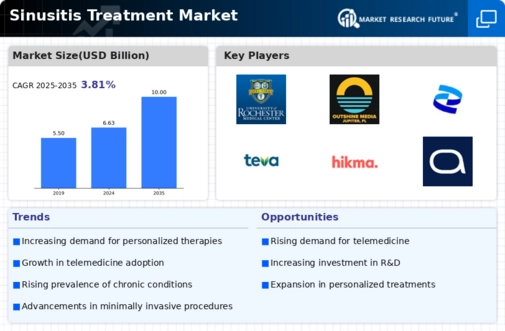Integration of Telemedicine
The integration of telemedicine into healthcare practices is transforming the Sinusitis Treatment Market. Telehealth services enable patients to consult with healthcare providers remotely, facilitating access to care for those who may have difficulty visiting clinics. This trend is particularly beneficial for individuals with chronic sinusitis, as it allows for ongoing management and follow-up without the need for in-person visits. The convenience of telemedicine may encourage more patients to seek treatment, thereby increasing the overall demand for sinusitis therapies. As telehealth continues to evolve, it is likely to play a pivotal role in shaping the future of the Sinusitis Treatment Market.
Growing Geriatric Population
The aging population is a significant factor contributing to the growth of the Sinusitis Treatment Market. Older adults are more susceptible to sinusitis due to age-related changes in the immune system and increased prevalence of comorbidities. As the global population ages, the number of individuals experiencing sinusitis is likely to increase. This demographic shift necessitates the development of tailored treatment strategies that address the unique needs of older patients. Consequently, healthcare providers and pharmaceutical companies may need to focus on creating effective treatment options for this population segment, further driving the Sinusitis Treatment Market.
Rising Incidence of Sinusitis
The increasing prevalence of sinusitis is a primary driver for the Sinusitis Treatment Market. Studies indicate that sinusitis affects approximately 29 million individuals annually in the United States alone. This rising incidence is attributed to various factors, including environmental changes, allergens, and respiratory infections. As more individuals seek treatment for sinusitis, the demand for effective therapies and medications is likely to grow. This trend suggests that pharmaceutical companies and healthcare providers may need to adapt their strategies to meet the needs of a larger patient population. Consequently, the Sinusitis Treatment Market is poised for expansion as healthcare systems respond to this growing demand.
Advancements in Treatment Options
Innovations in treatment modalities are significantly influencing the Sinusitis Treatment Market. Recent developments in pharmacological therapies, including the introduction of biologics and targeted therapies, have enhanced treatment efficacy. For instance, the approval of new medications that specifically target inflammatory pathways has provided patients with more effective options. Additionally, minimally invasive surgical techniques have improved patient outcomes and reduced recovery times. These advancements not only improve patient satisfaction but also encourage healthcare providers to adopt new treatment protocols. As a result, the Sinusitis Treatment Market is likely to experience growth driven by the availability of advanced treatment options.
Increased Awareness and Education
Heightened awareness regarding sinusitis and its treatment options is driving the Sinusitis Treatment Market. Public health campaigns and educational initiatives have played a crucial role in informing patients about the symptoms and potential complications of untreated sinusitis. This increased awareness encourages individuals to seek medical advice sooner, leading to earlier diagnosis and treatment. Furthermore, healthcare providers are increasingly focusing on educating patients about the importance of adherence to treatment regimens. As patients become more informed, the demand for effective sinusitis treatments is expected to rise, thereby positively impacting the Sinusitis Treatment Market.


















Leave a Comment